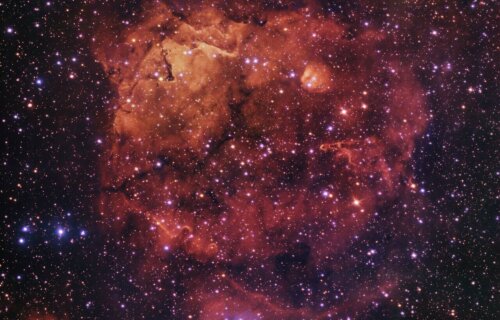ANTOFAGASTA, Chile — When astronomers look up into space, there’s an infinite number of possibilities they can find from brand new planets to exploding stars. While we haven’t discovered proof of aliens, astronomers from the European Southern Observatory (ESO) have captured the next best thing — a giant smiling cat!
The Sh2-284 nebula is filled with young stars. Its stellar nursery also contains gas and dust that clump together to create new suns like our own. The brightest part of this nebula is about 150 light-years across. From Earth, it’s about 15,000 light-years away, in the Monoceros constellation. Most notably, however, if you look at the cloud as a whole, there is a striking resemblance to a smiling cat looking down at the galactic sky.
Looking at the giant region as different parts of a cat’s face is actually helping astronomers observe different phenomena. Under the “cat’s nose” is the center of the bright part of the nebula. This area contains a special bunch of young stars called Dolidze 25. These stars help create strong radiation. The radiation emitted from the stars is powerful enough to ionize the hydrogen gas in the clouds giving the nebula its distinctive orange and red color. Clouds like this create the optimal environments for new stars to live and grow.

This central group of stars also releases very strong winds that push away the gas and dust from the center of the nebula. The hollowed and dust-free area contains dense pockets of stellar material. According to the ESO astronomers who captured this image, these pockets give the center protection and are the last to get eroded. On the right-hand side of the picture, the hollow center creates several pillars along the edges of Sh2-284. They may be hard to see at first glance from the image but don’t think they are small in person. These pillars are several light-years wide and contain large amounts of gas and dust where new stars are born.

The VLT Survey Telescope, owned by the National Institute for Astrophysics in Italy, took images of the orange and red clouds that make up the Sh2-284 nebula. Housed in ESO’s Paranal Observatory in Chile, this powerful telescope is helping to map out the southern sky with a 256-million-pixel camera ideal for capturing wide-field images. The smiling cat picture is part of the VST Photometric Hα Survey of the Southern Galactic Plane and Bulge (VPHAS+), which has studied some 500 million objects in our home galaxy, helping us better understand the birth, life, and eventual death of stars within our Milky Way.

